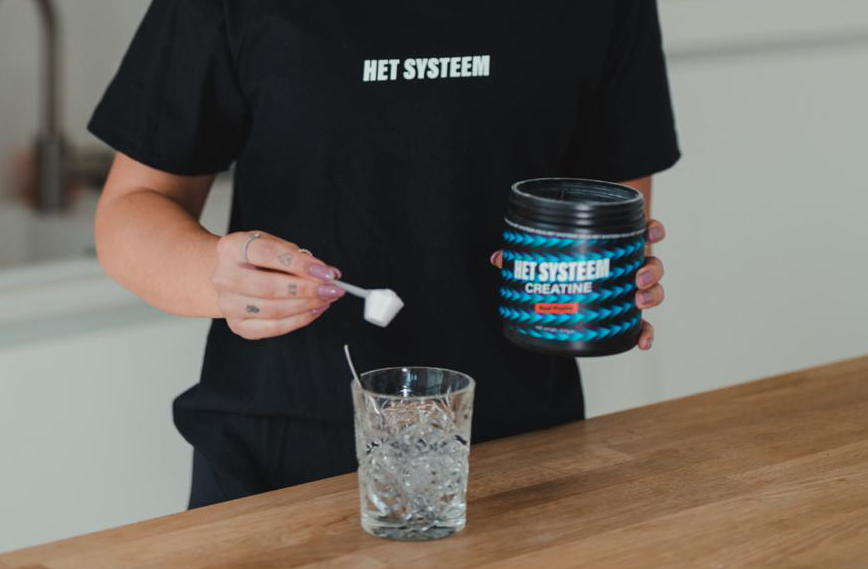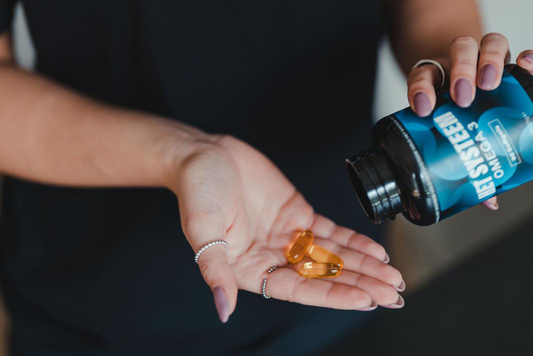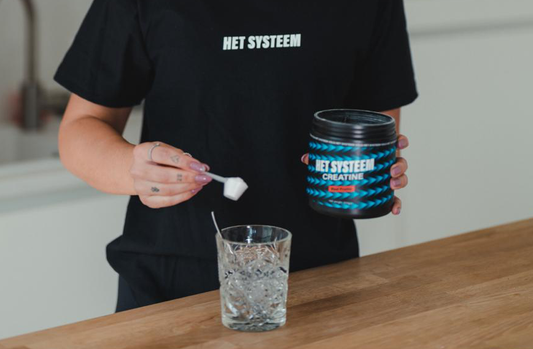
Creatine
Creatine, what is it?
Creatine is a molecule that is created by the transformation of amino acids. This takes place in the liver and pancreas, but can also be absorbed through food such as meat, fish and poultry. Most of the storage sites are in our skeletal muscles.
The body needs energy to function. This energy is called ATP (Adenosine Triphosphate). ATP is broken down into ADP (Adenosine Diphosphate) and a loose phosphate group (P). This releases energy, leaving two phosphate molecules (Adenosine Diphosphate). The ability to convert ADP back to ATP during intense and short-term activities is largely dependent on creatine phosphate (CP). This is stored in the muscle fibers. Creatine helps to reuse this ATP by separating the phosphate (P) from the creatine phosphate and adding it to the ADP, creating ATP again.
For whom?
Simply put, for everyone. Women, men, strength, endurance and even non-athletes can benefit from creatine supplementation. Creatine is 100% safe for healthy people. It is even recommended for older people to continue supporting their quality of life because of the cognitive benefits and the ability to combat sarcopenia.
What are the benefits of Creatine Monohydrate?
- Improves high-intensity efforts (Izguierdo et al, 2002)
- Improves training quality (Rawson et al, 2003)
- Increases strength (Rawson et al, 2003)
- Improves recovery (Cottrell et al, 2002)
- Improves training adaptations (Cottrell et al, 2002)
- Improves muscle endurance (Chwalbinska-Moneta, 2003)
- Increases glycogen storage (Nelson et al, 2001)
- Improves cognitive functions (Rae et al, 2007)
- Increases lean body mass (also in vegetarians) (Burke et al, 2003)
- Improves performance (Burke et al, 2003)
- Helps to counteract the effects of sleep deprivation (McMorris et al, 2006)
- Improves sprint performance (Mujika et al, 2000)
- Safe in adolescents and young people (Jagim et al, 2018)
In short: better performance and better recovery.
Recommended dose?
Creatine can be taken in two ways:
- Charging phase followed by a maintenance phase
- Immediately the maintenance phase
In a loading phase you take 20g (spread over 4 doses) for 5 to 7 days. After this period you switch to a maintenance phase of 3 to 5g per day. By working this way you can experience the benefits faster. The only disadvantage is that some may experience stomach problems.
To avoid these stomach problems, it is better to start the maintenance phase immediately. The effects will take a little longer to appear, but this way you avoid stomach problems.
Timing of intake
It doesn't matter when you take creatine. The most important thing is that you do this every day at a time that is most suitable for you.
If you really want to pay attention to the details, it is best to take this with a carbohydrate-rich meal and after training. Studies show that this is the most ideal scenario despite very minimal differences.
What kind?
There are many different types of creatine on the market and each claims to be better than its predecessor. In the meantime, many studies have been carried out and every time Creatine Monohydrate comes out as the best. The effect is much better and is much cheaper than all other types.
What are the disadvantages?
As just mentioned, stomach problems can occur. If this is the case, skip the loading phase and immediately go to a maintenance phase.
The use of creatine can cause a small increase in weight. You're probably panicking a little? Do not panic! Weight gain is NOT FAT GAIN. There will be some extra water retained, but this is not fat! That extra bit of water is itself a good sign. The muscles will look 'fuller'. This means that the supplement is doing its job.
MYTHS
- Bad for the kidneys: A myth that has been around for a long time is that using creatine is harmful to the kidneys. Studies show that creatine does not cause damage to the kidneys and is perfectly safe for people without existing kidney problems.
- Rest periods are necessary: if you take rest periods, you have to replenish the stores in the muscles afterwards, so you have to wait again for the many benefits.
- Muscle cramps: creatine does not cause muscle cramps as claimed by many.
Conclusion
Creatine for everyone, anytime, anywhere!



